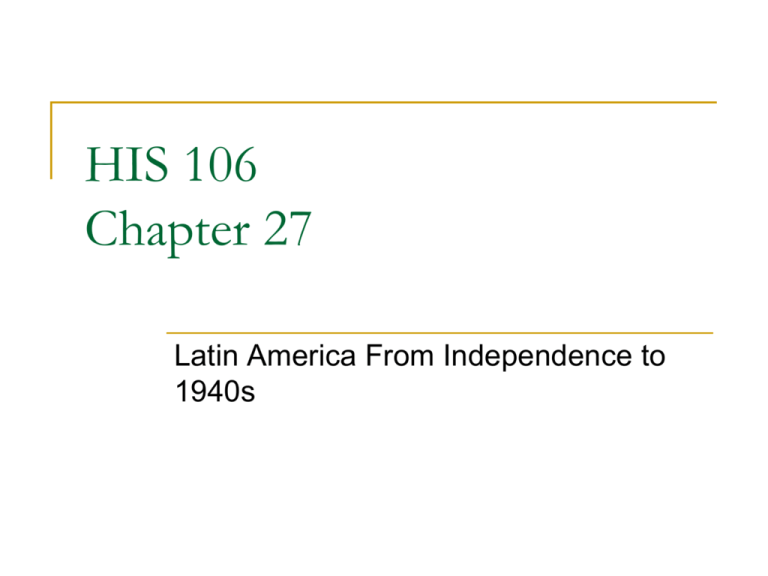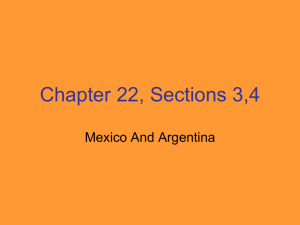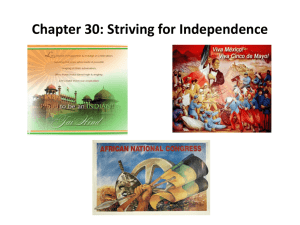HIS 106 Chapter 27
advertisement

HIS 106 Chapter 27 Latin America From Independence to 1940s Latin America Wanted independence for the same reasons as the U.S. did U.S. shares European heritage with Latin America Despite similarities, economic and political development of Latin America is different from that of Europe or the United States Latin America has been less stable and less prosperous than Europe and North America Perhaps neocolonialism can account for that; they were economically dependent on others even though they were independent politically Brazil, however, was different; it prospered right after independence Brazil had a monarchy for 67 years after independence and retained slavery until 1888 When the other republics broke from Spain, they lost their major trading partner The wars for independence had been fought in South America, so the damage was right in their backyards Flooded mines Disruption of agriculture Scattered labor force Not everyone backed the new governments run by Creole elite. Many Latin American governments looked to Britain for protection Another problem for new governments was that the elites opposed social reform All newly independent nations grated equal rights, except for Brazil However: Peasants were still subservient to landowners Voting depended on how much property a person owned –disenfranchising many Racial prejudice remained There were no social revolutions to change the status quo (rule by the elites), except for Mexico, until the 1950s Land was dominated by the hacienda system Work was harsh Peasants lived on the haciendas They could leave if they paid off their debts to the landowner – debt peonage – virtually never happened Transportation was difficult at best, so many stayed where they were born No education for the peasants or Indians, so they couldn’t improve their lives During second half of 19th century, some moved to the cities creating an urban poor and social discontent The elites in control put down any uprisings Economy Relied on exporting raw materials and importing manufactured goods In the 19th century, they dealt primarily with Britain In the 20th century, they dealt with the U.S. To get more land for raw material use, governments confiscated both Church and Indian lands because they weren’t using it efficiently The military who were often the best educated elites adopted a French philosophy of August Comte called Positivism Advocated technological progress Technocrats and authoritarians could best achieve modernization of economy They also accepted European theories of “scientific racism” that basically said that whites are good and non white are bad or less good. Whites, therefore, should be at the top. The theory stated that if an area was economically backward, the non-whites and the mixed bloods are to blame -- not the governments of white elites The military believed this, and they were very influential in government Mexico Government was very conservative from time of independence until 1910 No social overhauls during that time Agustin de Iturbide Was the first ruler from 1820 – 1823 Governed as emperor Died in 1824 For the rest of the century, Mexico had strong dictators with ties to the military - Caudillos Iturbide Antonio Lopez de Santa Anna one of the strongest caudillos The general who fought the United States over Texas Exiled in in 1855 as a result of La Reforma, a movement against Santa Anna’s dictatorship They wanted Economic progress Civilian rule Political stability Anti-Church La Reforma led to civil war Benito Juarez Came to power in 1861 Faced: Backward agriculture as a result of the hacienda system Mines in poor condition Primitive transportation Few domestic industries Debts to foreigners Clerics and conservatives asked Austrian Archduke Maximilian, backed by France, to become Emperor of Mexico 1867 – Juarez captured and executed Maximilian; picture p. 609 Liberals like Juarez held power until 1876; he never really had popular support because of how they treated the Catholic Church Maximilian Porfirio Diaz Ruled from 1876 – 1911 Dictator Stayed in power by giving everyone just a little of what they wanted Made peace with the Church Suppressed his opponents Allowed foreigners to invest, especially the U.S. By 1900, U.S. owned $2 billion in Mexican property. We owned most of the railroads, 60% of oil wells, and most of the mines. Diaz retained the hacienda system 95% of Mexicans had no land Wages went down Porfirio Diaz was overthrown by Francisco Madero This ushered in 10 years of revolution where 1 in every 8 Mexicans was killed and 2 presidents were assassinated. Francisco Madero Ruled from 1911- 1913 Idealist Wanted democracy Was assassinated by his own general, Victoriano Huerta Victoriano Huerta Overthrown with the help of U.S. Woodrow Wilson didn’t like having an assassin as president of Mexico Ruled from 1913-1914 Venustiano Carranza Ruled from 1914 -1920 Set up a constitution but didn’t enforce it Called for land redistribution Announced “Mexico is for Mexicans” Still allowed U.S. to invest in Mexico Challenged by Pancho Villa and Emiliano Zapata. Zapata led an agrarian reform movement and had the support of peasants. He was assassinated in 1919 Carranza was assassinated in 1920 In the 1920s, Obregon and Plutarco Calles took power. They tried to modernize a bit They redistributed some land Calles organized the PRI, the Institutional Revolution Party The PRI remained in power for the rest of the 20th century Lazaro Cardenas Became president in 1934 Tried to fulfill the promises made in 1917 by Carranza Had support of the peasants Redistributed 44 million acres of land and broke the hacienda system Took strong stand against the U.S. by seizing control of its oil industry and other properties, offering to reimburse Americans for their losses Americans felt the offer was too low, and didn’t readily accept it FDR finally did because he remembered how Germany wanted to get Mexico to attack U>S., so that U.S. wouldn’t enter World War I. Things were heating up again in Europe This kept Mexico and South America on Allied side in World War II Manuel Avila Camacho Elected in 1940 Worked on economic development Government was democratic taking on its social responsibilities Camacho Argentina There were 3 distinct eras between the time of independence and World War II 1. 1810-mid-century Rebellion against Spain Internal struggles to see which region would be dominant 2. 1853 – 1916 Economic expansion European immigration that transformed their society 3. 1916 – 1943 - a failed democratic state - an economy they did not control 1810 – Mid-Century Internal struggles after throwing off Spain Buenos Aires came out on top and dominated trade as a port city Commercial treaty of 1823 named Britain as main trading partner Juan Manuel de Rosas became dictator of Buenos Aires Negotiated the Pact of the Littoral that put Buenos Aires in charge of trade and foreign relations de Rosas Rosas Expanded trade Suppressed Indians Encouraged nationalism Other provinces resented Rosas 1852 – Rosas was overthrown 1853 - 1916 1853, Argentine Republic established and Buenos Aires remained dominant Had agricultural economy, mainly animal products Internal transportation was poor Country was sparsely populated 1876, technology entered in the form of a refrigerated ship to transport beef Wheat growing expanded to the pampas British constructed and managed a railroad Wheat and beef production increased making Argentina one of the richest nations in Latin America By 1900, Argentina was much more urbanized and industrialized Professionals and the middle class wanted more say in government and an end to corruption This led to the formation of the Radical Party in 1890 This brings in the 3rd era: 1916 – 1943 The leader of the Radical Party was Hipolito Irigoyen He was elected president in 1916 He promised to improve the lives of peasants and the middle class His government became corrupt and power returned to the landed elites Hipolito Irigoyen 1930, a military coup returned power to conservatives Argentina was still dependent on Britain for its export market ---- this was the time of the Great Depression and Argentina was also affected Nacionalismo arose among many of the educated in the 1930s Nacionalismo Similar to European Fascism Saw British and American dominance of their economy as imperialism Rejected liberalism Hated communism Were anti-Semitic Supported the Catholic Church Advocated social reforms for workers and the poor Supported caudillos 1943, military took power Hostile to Britain Admired fascism Wanted to address social problems wanted to industrialize to get out from under foreign influence Colonel Juan Peron took part in the coup and was put in charge of trade unions. He gained their support and was more popular than the president Juan and Eva Peron Juan Peron Was authoritarian Was anti-communist Was socially progressive Seized power in 1946 saying he had working class support and help from his actress wife, Eva Was a caudillo with popular backing Eva Peron died in 1952 Juan Peron was ousted in 1955 Argentina was still unstable Brazil Portuguese Colony Independence in 1820s Established a monarchy Pedro I gave constitution but abdicated in 1831 Pedro II his 15 year old son took power in 1831 – 1889. He was a constitutional monarch who brought stability Monarchy overthrown in 1889 Army overthrew the monarchy because it freed the slaves Established a republic dominated by coffee plantation owners Brazilian Republic 1891-1930 Coffee was king Military coup in 1930 brought in Getulio Vargas Getulio Vargas Was in power 1930-1945 Gave concessions to the workers Built industry Became a dictator 1945 – another military coup took Vargas out of power. They then brought in democracy with foreign-financed industry. 1950 – Vargas was elected president He ws elderly and not as sharp When a staffer became involved in the assassination of a reporter, Vargas had to resign Vargas committed suicide in 1954 Brazil remained an unstable democracy 1957 – a capital city was built inland, Brasilia Poverty and illiteracy remained problems In early 1960s – Joao Goulert took power Was a leftist Wanted land reform Questioned military influence in government 1964, military over threw Goulert No more democracy





